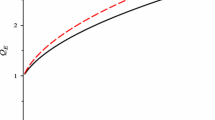Abstract
The Boltzmann equation is used to calculate the time correlation function and the fluctuation spectrum for electrons obeying classical statistics. The stationary joint distribution for one electron to be initially ink 0=k(0) and finally ink=k(t) is given by the product of the conditional probability and the stationary distribution. These quantities can be found from the Boltzmann equation if there exists, for any initial distribution, a unique solution which satisfies the Markov equation and tends to a stationary solution for large times under stationary conditions. It is proved that these conditions hold for linear collision operators and in the relaxation approximation. General operator expressions for the fluctuation spectrum and the differential conductivity in a stationary electric field are given, which can be evaluated within the usual approximation schemes known for the stationary, nonequilibrium solutions of the Boltzmann equation. In equilibrium they reproduce the classical fluctuation dissipation theorem. In a nonequilibrium state they define a noise temperature depending on the field. In the relaxation approximation and for polynomial band structure the exact solution can be found. For parabolic and biparabolic spherical bands the result is discussed explicitly.
Zusammenfassung
Die Boltzmanngleichung wird zur Berechnung der Zeitkorrelationsfunktion und des Schwankungsspektrums von Elektronen mit klassischer Statistik benützt. Die stationäre Verbundverteilung für ein Elektron, das anfangs ink 0=k(0) und später ink=k(t) ist, läßt sich als Produkt der bedingten Wahrscheinlichkeit und der stationären Verteilung berechnen. Diese Größen folgen aus der Boltzmanngleichung, falls diese für jede Anfangsverteilung eine eindeutige Lösung besitzt, welche der Markov-Gleichung genügt und unter stationären Bedingungen nach genügend langer Zeit gegen die stationäre Lösung strebt. Für lineare Stoßoperatoren und in der Relaxationsapproximation sind diese Voraussetzungen erfüllt. Es werden allgemeine Operatorausdrücke für das Fluktuationsspektrum und die differentielle Leitfähigkeit angegeben, die im Rahmen der üblichen Approximationsmethoden zur stationären Lösung der Boltzmanngleichung ausgewertet werden können. Im thermischen Gleichgewicht reproduzieren sie das klassische Fluktuations-Dissipations-Theorem. Im Nichtgleichgewichtszustand definieren sie eine vom Feld abhängige Rauschtemperatur. In der Relaxationsapproximation wird die exakte Lösung für eine polynomiale Bandstruktur berechnet. Für parabolische und biparabolische sphärische Bänder wird das Ergebnis explizit diskutiert.
Résumé
L’équation de Boltzmann est appliquée pour le calcul de la fonction de correlation temporale et du spectre de fluctuation des électrons obéissant la statistique classique. La distribution stationnaire pour un électron se trouvant ak=k(t) et qui était initialement àk 0=k(0) est le produit de la probabilité conditionelle et de la distribution stationnaire. Ces quantités se derivent de l’équation de Boltzmann, s’il possède une solution unique pour chaque distribution initiale, qui satisfait l’équation de Markov et converge sous conditions stationnaires vers la solution stationaire après une durée suffissamment longue. Cettes conditions sont valable pour des operateurs de collision linéaires et dans l’approximation de rélaxation. Des expressions opérationnelles sont derivées pour le spectre des fluctuations et la conductivité differentielle; elles peuvent être appliquées avec les méthodes approximatives usuelles pour trouver les solutions stationnaires de l’équation de Boltzmann. Dans l’état d’équilibre thermique elles reproduisent le théorème classique de fluctuation-dissipation. Dans l’état de nonéquilibre elles definissent une temperature de bruit, dépandant du champ électrique. Dans l’approximation de rélaxation la solution exacte est calculée pour une structure d’énergie polynomiale. Pour des bandes parabolique et biparabolique les résultats sont discutées en détail.
Similar content being viewed by others
Literatur
Cohen, E. G. D.: Fundamental problems in statistical mechanics, p. 110–156. Amsterdam: North Holland 1962.
Kohn, W., andJ. M. Luttinger: Phys. Rev.108, 590 (1957).
Holland, B. W.: Proc. Phys. Soc.86, 1153 (1965).
Fröhlich, H., andA. W. B. Taylor: Proc. Phys. Soc.83, 739 (1964).
Callen, H. B., andT. A. Welton: Phys. Rev.83, 34 (1951).
Pytte, E.: Im Druck.
Richardson, J. M.: IRE Trans. IT-1, 62 (1955).
Lax, M.: Rev. mod. Phys.32, 25 (1960).
Price, P. J.: Chapt. 8 from Fluctuation phenomena in solids, edited byR. E. Burgess. New York and London: Academic Press 1965.
Schlup, W. A.: Phys. kondens. Materie7, 124 (1968).
Nyquist, H.: Phys. Rev.32, 110 (1928).
Guenault, A. M., andD. K. C. MacDonald: Physica30, 309 (1964).
Kampen, N. G. van: Physica26, 585 (1960); J. math. Phys.2, 592 (1961).
Fokker, A. D.: Ann. Phys.43, 812 (1914). —Planck, M.: Sitzungsber. preuss. Akad. Wiss. phys. math. Kl., p. 324 (1917). —Kramers, H. A.: Physica7, 284 (1940).
Pawula, R. F.: Phys. Rev.162, 186 (1967).
Chandrasekhar, S.: Rev. mod. Phys.15, 1 (1943).
Kampen, N. G. van: Chapt. 5 from Fluctuation phenomena in solids. Edited byR. E. Burgess. New York and Loodon: Academic Press 1965.
Ford, G. W., M. Kac, andP. Mazur: J. math. Phys.6, 504 (1965).
Green, M. S.: J. Chem. Phys.20, 1281 (1952).
Ramakrishnan, A.: Probability and stochastic processes. Handbuch der Physik, Vol. III/2, herausgegeben vonS. Flügge. Berlin-Göttingen-Heidelberg: Springer 1959.
Author information
Authors and Affiliations
Rights and permissions
About this article
Cite this article
Schlup, W.A. Das Fluktuationsspektrum von Elektronen in einem stationären Nichtgleichgewichtszustand. Phys kondens Materie 8, 167–193 (1968). https://doi.org/10.1007/BF02422722
Received:
Issue Date:
DOI: https://doi.org/10.1007/BF02422722



